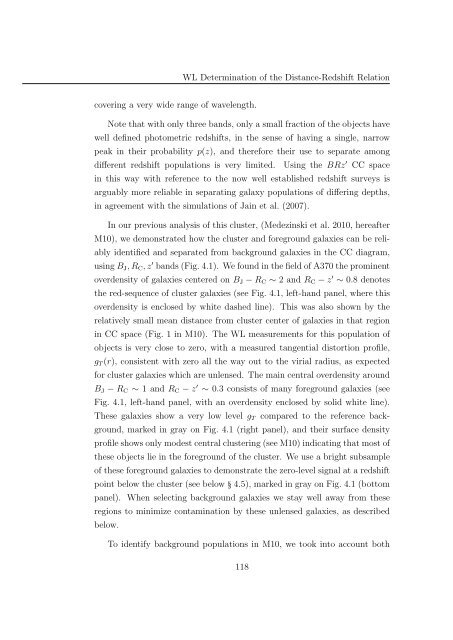Mass and Light distributions in Clusters of Galaxies - Henry A ...
Mass and Light distributions in Clusters of Galaxies - Henry A ...
Mass and Light distributions in Clusters of Galaxies - Henry A ...
Create successful ePaper yourself
Turn your PDF publications into a flip-book with our unique Google optimized e-Paper software.
WL Determ<strong>in</strong>ation <strong>of</strong> the Distance-Redshift Relation<br />
cover<strong>in</strong>g a very wide range <strong>of</strong> wavelength.<br />
Note that with only three b<strong>and</strong>s, only a small fraction <strong>of</strong> the objects have<br />
well def<strong>in</strong>ed photometric redshifts, <strong>in</strong> the sense <strong>of</strong> hav<strong>in</strong>g a s<strong>in</strong>gle, narrow<br />
peak <strong>in</strong> their probability p(z), <strong>and</strong> therefore their use to separate among<br />
different redshift populations is very limited. Us<strong>in</strong>g the BRz ′ CC space<br />
<strong>in</strong> this way with reference to the now well established redshift surveys is<br />
arguably more reliable <strong>in</strong> separat<strong>in</strong>g galaxy populations <strong>of</strong> differ<strong>in</strong>g depths,<br />
<strong>in</strong> agreement with the simulations <strong>of</strong> Ja<strong>in</strong> et al. (2007).<br />
In our previous analysis <strong>of</strong> this cluster, (Medez<strong>in</strong>ski et al. 2010, hereafter<br />
M10), we demonstrated how the cluster <strong>and</strong> foreground galaxies can be reliably<br />
identified <strong>and</strong> separated from background galaxies <strong>in</strong> the CC diagram,<br />
us<strong>in</strong>g B J , R C , z ′ b<strong>and</strong>s (Fig. 4.1). We found <strong>in</strong> the field <strong>of</strong> A370 the prom<strong>in</strong>ent<br />
overdensity <strong>of</strong> galaxies centered on B J − R C ∼ 2 <strong>and</strong> R C − z ′ ∼ 0.8 denotes<br />
the red-sequence <strong>of</strong> cluster galaxies (see Fig. 4.1, left-h<strong>and</strong> panel, where this<br />
overdensity is enclosed by white dashed l<strong>in</strong>e). This was also shown by the<br />
relatively small mean distance from cluster center <strong>of</strong> galaxies <strong>in</strong> that region<br />
<strong>in</strong> CC space (Fig. 1 <strong>in</strong> M10). The WL measurements for this population <strong>of</strong><br />
objects is very close to zero, with a measured tangential distortion pr<strong>of</strong>ile,<br />
g T (r), consistent with zero all the way out to the virial radius, as expected<br />
for cluster galaxies which are unlensed. The ma<strong>in</strong> central overdensity around<br />
B J − R C ∼ 1 <strong>and</strong> R C − z ′ ∼ 0.3 consists <strong>of</strong> many foreground galaxies (see<br />
Fig. 4.1, left-h<strong>and</strong> panel, with an overdensity enclosed by solid white l<strong>in</strong>e).<br />
These galaxies show a very low level g T compared to the reference background,<br />
marked <strong>in</strong> gray on Fig. 4.1 (right panel), <strong>and</strong> their surface density<br />
pr<strong>of</strong>ile shows only modest central cluster<strong>in</strong>g (see M10) <strong>in</strong>dicat<strong>in</strong>g that most <strong>of</strong><br />
these objects lie <strong>in</strong> the foreground <strong>of</strong> the cluster. We use a bright subsample<br />
<strong>of</strong> these foreground galaxies to demonstrate the zero-level signal at a redshift<br />
po<strong>in</strong>t below the cluster (see below § 4.5), marked <strong>in</strong> gray on Fig. 4.1 (bottom<br />
panel). When select<strong>in</strong>g background galaxies we stay well away from these<br />
regions to m<strong>in</strong>imize contam<strong>in</strong>ation by these unlensed galaxies, as described<br />
below.<br />
To identify background populations <strong>in</strong> M10, we took <strong>in</strong>to account both<br />
118
















